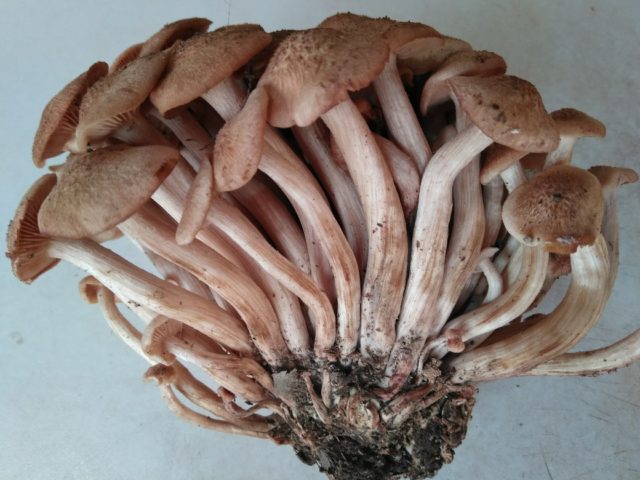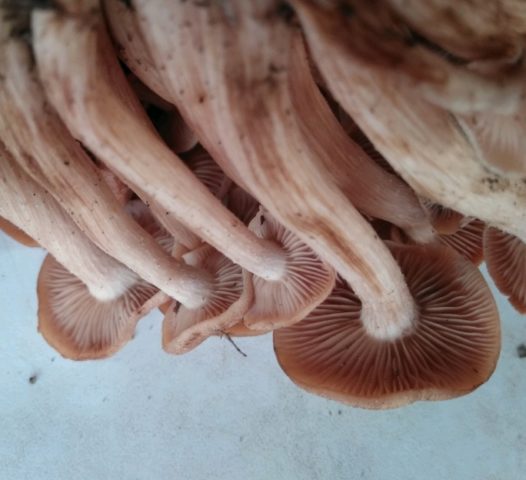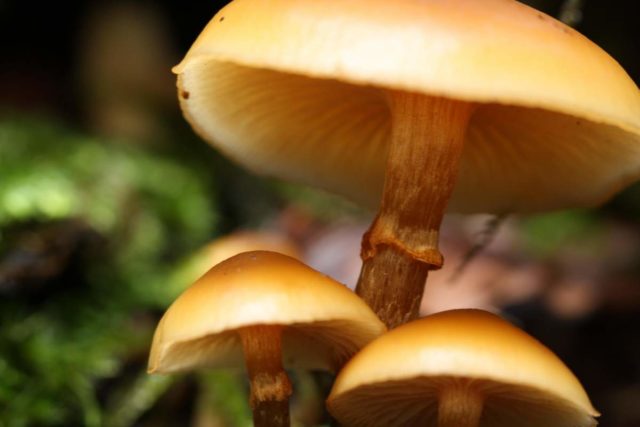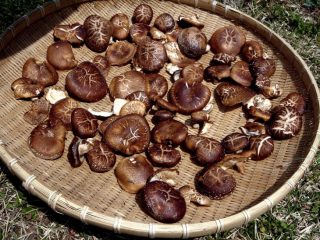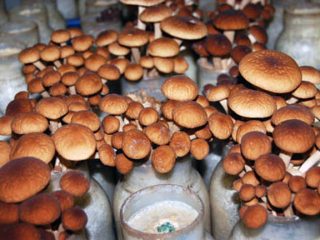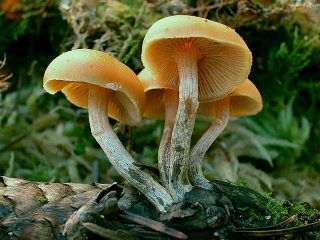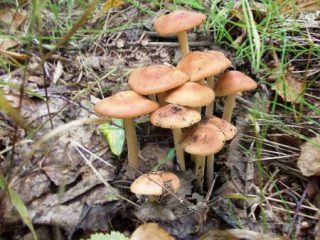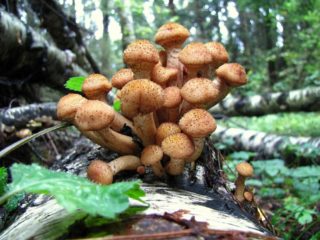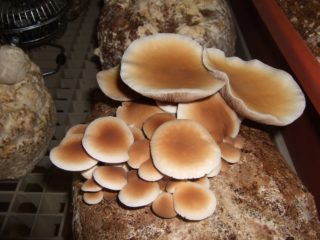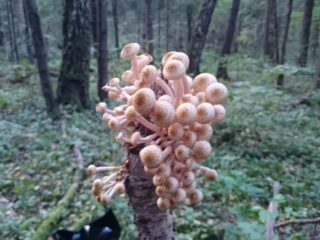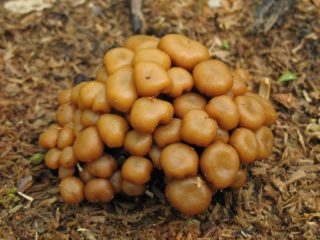Content
In central Russia, a rich harvest of summer and autumn honey mushrooms is not uncommon. They are especially valued by mushroom pickers for their high taste and pleasant aroma. This variety of mushrooms, the dry honey fungus, is widespread in coniferous and deciduous forests of the middle regions.It is great for preparing various dishes and pickles, and is also famous for its medicinal properties and is greatly loved by true gourmets.
Description of shrinking honey mushroom
Drying honey fungus, or ringless, has an average size - up to 15 cm in height. Its white or milky-yellowish, sometimes brown flesh emits a pleasant, pronounced mushroom aroma. Its color does not change when cut. The mushroom belongs to the Physalacriaceae family, has a lamellar hymenophore of white color with a slightly pinkish tint.
Description of the cap
The maximum size of the cap is 10 cm. In young individuals it is convex, but subsequently expands and takes on a flattened shape. There is a wide tubercle in the center. The color of the cap is light brown, reddish, its surface is dry, covered with dark scales, which are characteristic of young mushrooms, and with age they gradually disappear.
Description of the leg
The height of the smooth stem of the drying honey mushroom varies from 7 to 18 cm, and its thickness is up to 1.5 cm. The color is uneven: closer to the cap it is white, with small dark patches, underneath it is brown or brown. Inside, the fibrous stem is hollow, there is no ring, which explains the second name - ringless honey fungus. The fruiting bodies are fused together by the lower parts of the stalks.
Where and how does the drying honey mushroom grow?
Drying honey mushrooms are common in central and southern Russia; they are also found in Crimea. They grow on rotting wood, stumps of coniferous and deciduous trees in large groups, forming characteristic clumps. The favorite place of these mushrooms is oak wood. They are collected from June until late autumn. In the southern regions, they actively bear fruit until the coldest weather, that is, until December.The ringless mushroom also grows in North America, Europe, Japan, China, as well as in northern African regions.
Edible ringless honey fungus or not
Shrinking honey mushrooms are classified as edible mushrooms with excellent taste and a unique chemical composition. They are characterized by a strong mushroom aroma and pulp with an astringent, without the presence of bitterness, taste. To prepare honey mushrooms, no special, complex heat treatment is required. Before cooking, it is enough to clean and rinse the fruiting bodies thoroughly. Then they are fried, boiled, salted, pickled, and cooked in soups and sauces.
How to cook shrinking honey mushrooms
A variety of dishes are prepared from drying mushrooms - tasty, very aromatic and healthy. It is necessary to process mushrooms immediately after they have been brought home from the forest. The maximum shelf life of fresh mushroom raw materials is 1 day. During primary processing, they are cleaned, debris, rot and wormholes are removed. Rinse thoroughly under running water. The fruiting bodies of the shriveling variety prepared in this way can be boiled, fried, pickled, salted, and made into sauces.
How to pickle drying mushrooms
Marinated mushrooms are traditionally the most favorite dish of many housewives. To prepare drying mushrooms this way you will need:
- 700 g mushrooms;
- 1 tbsp. water;
- 30 ml vegetable oil;
- 1.5 tbsp. l. vinegar;
- 1 tbsp. l. salt and sugar;
- spices - 2 pcs. bay leaf, cloves, black peppercorns and garlic cloves.
Cooking algorithm:
- The fruit bodies are boiled in salted water for 20 minutes.
- Place in a colander and allow the liquid to drain.
- Boil the marinade from the above ingredients, except vinegar and oil, in a saucepan for 5 minutes.
- Add mushrooms and boil for 10 - 15 minutes. and pour in vinegar.
- Place in sterilized jars, add oil on top and seal with lids.
How to salt ringless honey mushrooms for the winter
Crispy, moderately salty, shrinking mushrooms are a great addition to the table in the winter. To prepare them you will need:
- 1 kg honey mushrooms;
- 50 g vegetable oil;
- 2 onions;
- 50 g salt;
- dill umbrellas.
Cooking algorithm:
- Boil the fruiting bodies for 30 minutes. in salted water.
- The broth is drained.
- The mushrooms are placed in an enamel pan in layers, sprinkling each with salt and onion rings.
- Add 50 ml of boiled cold water, cover with a plate and set the oppression with a load.
- Place the pan in a cool place, maybe in the refrigerator for 30 days.
- The salted fruiting bodies are transferred to glass jars and covered with plastic lids.
How to dry drying honey mushrooms for the winter
When dried, honey mushroom is perfectly stored all winter and serves as the basis for preparing many dishes. It is this method of processing that allows you to preserve the maximum amount of useful microelements in mushrooms.
Drying is carried out:
- on air;
- in the oven;
- in an electric dryer.
Before drying, the fruiting bodies are cleaned and large specimens are cut. String on a thread and hang in a well-ventilated, sunny place for 30 - 40 days. In the oven, the drying process takes about 5 hours at a temperature of 60 °C, during which the mushrooms are periodically turned over. In 3 - 4 hours, ringless honey mushrooms are dried in an electric dryer at a temperature of 50 °C.After this, they are left with the device turned off for another 3 hours. Fruiting bodies that are properly prepared for storage are springy and non-fragile. Overdried - when pressed they crumble.
The benefits and harms of shriveling mushrooms
Due to its unique composition, drying honey mushrooms have medicinal properties. The amount of amino acids, biologically active substances and polysaccharides contained in these mushrooms that are useful for the human body is difficult to overestimate.
Eating them stimulates:
- work of the gastrointestinal tract;
- excretion of bile;
- decreased blood pressure;
- strengthening the immune system.
The use of shrinking honey mushrooms allows you to eliminate rapid heartbeat, various inflammations and pain. Clinical studies have confirmed that the product stimulates the human body to fight sarcoma, reduces radiation levels and removes toxins.
However, in some cases, harm is possible under certain conditions:
- exacerbation of chronic diseases of the gastrointestinal tract;
- pregnancy and breastfeeding.
Doubles and their differences
Most of all, shrinking honey mushrooms are similar to mushrooms of the genus Galerina, of which there are edible and poisonous representatives. Among them:
- Autumn honey fungus differs from the shrinking one by the presence of a ring on the stem and white, beige plates. Grows only in deciduous forests. Belongs to the edible variety.
- Bordered gallery has rusty spores, a brown cap and a membranous ring on the stalk. The favorite habitat is rotting coniferous trees. Poisonous mushroom.
- Sulfur-yellow honey fungus has a yellow or brown cap, darker in color in the center than at the edges. Prefers deciduous forests, but is also found in coniferous forests, although much less frequently. Poisonous mushroom.
It is quite difficult to distinguish between the dry honey fungus and the yellow milk mushroom, which prefers fir forests and also lives under spruce and birch trees. However, the latter has a funnel-shaped cap, which is very large in size - up to 25 cm in diameter. Its surface is slimy, whereas in the ringless representative of the honey fungus it is dry. The leg of the milk mushroom is covered with yellow dents. When cut, the flesh darkens and secretes a lot of milky juice.
Conclusion
Drying honey fungus is a mushroom unique in its properties and taste, which should not be ignored during a “quiet hunt”. Healthy dishes made from this product will greatly diversify the winter table, and they will also be indispensable for vegetarians. A bonus to this is the healing effect that the honey fungus will have on the human body.
